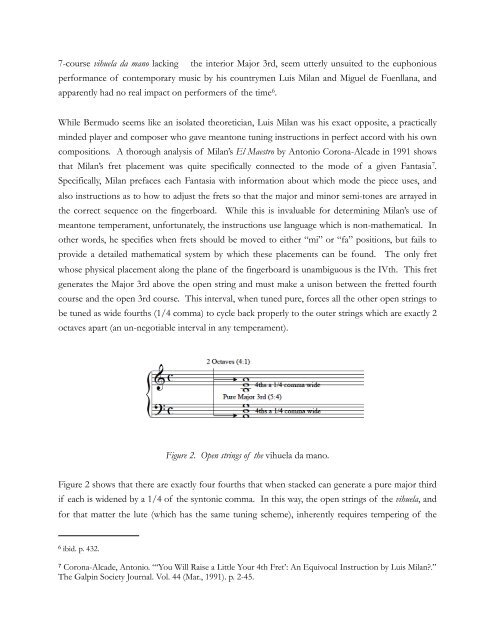the-rule-of-31
the-rule-of-31
the-rule-of-31
Create successful ePaper yourself
Turn your PDF publications into a flip-book with our unique Google optimized e-Paper software.
7-course vihuela da mano lacking <strong>the</strong> interior Major 3rd, seem utterly unsuited to <strong>the</strong> euphonious<br />
performance <strong>of</strong> contemporary music by his countrymen Luis Milan and Miguel de Fuenllana, and<br />
apparently had no real impact on performers <strong>of</strong> <strong>the</strong> time 6 .<br />
While Bermudo seems like an isolated <strong>the</strong>oretician, Luis Milan was his exact opposite, a practically<br />
minded player and composer who gave meantone tuning instructions in perfect accord with his own<br />
compositions. A thorough analysis <strong>of</strong> Milan’s El Maestro by Antonio Corona-Alcade in 1991 shows<br />
that Milan’s fret placement was quite specifically connected to <strong>the</strong> mode <strong>of</strong> a given Fantasia 7 .<br />
Specifically, Milan prefaces each Fantasia with information about which mode <strong>the</strong> piece uses, and<br />
also instructions as to how to adjust <strong>the</strong> frets so that <strong>the</strong> major and minor semi-tones are arrayed in<br />
<strong>the</strong> correct sequence on <strong>the</strong> fingerboard. While this is invaluable for determining Milan’s use <strong>of</strong><br />
meantone temperament, unfortunately, <strong>the</strong> instructions use language which is non-ma<strong>the</strong>matical. In<br />
o<strong>the</strong>r words, he specifies when frets should be moved to ei<strong>the</strong>r “mi” or “fa” positions, but fails to<br />
provide a detailed ma<strong>the</strong>matical system by which <strong>the</strong>se placements can be found. The only fret<br />
whose physical placement along <strong>the</strong> plane <strong>of</strong> <strong>the</strong> fingerboard is unambiguous is <strong>the</strong> IVth. This fret<br />
generates <strong>the</strong> Major 3rd above <strong>the</strong> open string and must make a unison between <strong>the</strong> fretted fourth<br />
course and <strong>the</strong> open 3rd course. This interval, when tuned pure, forces all <strong>the</strong> o<strong>the</strong>r open strings to<br />
be tuned as wide fourths (1/4 comma) to cycle back properly to <strong>the</strong> outer strings which are exactly 2<br />
octaves apart (an un-negotiable interval in any temperament).<br />
Figure 2. Open strings <strong>of</strong> <strong>the</strong> vihuela da mano.<br />
Figure 2 shows that <strong>the</strong>re are exactly four fourths that when stacked can generate a pure major third<br />
if each is widened by a 1/4 <strong>of</strong> <strong>the</strong> syntonic comma. In this way, <strong>the</strong> open strings <strong>of</strong> <strong>the</strong> vihuela, and<br />
for that matter <strong>the</strong> lute (which has <strong>the</strong> same tuning scheme), inherently requires tempering <strong>of</strong> <strong>the</strong><br />
6 ibid. p. 432.<br />
7 Corona-Alcade, Antonio. “‘You Will Raise a Little Your 4th Fret’: An Equivocal Instruction by Luis Milan?.”<br />
The Galpin Society Journal. Vol. 44 (Mar., 1991). p. 2-45.



